French Creek State Park wildfire
By Dan Barringer, Crow’s Nest Preserve Manager
I had the opportunity yesterday to join a wildland firefighting crew cutting fireline and putting out spot fires that were leaping the firebreak trails at nearby French Creek State Park. The Incident Commander (IC) from the time of initial attack around 1 pm until I left around 11:30 pm was Natural Lands Trust’s own Darin Groff, Binky Lee Preserve Manager (and local fire warden). When I arrived fire chiefs and the IC had just returned from sizing up the fire and were developing strategy with maps, radios, and phones on the hood of Darin’s truck.
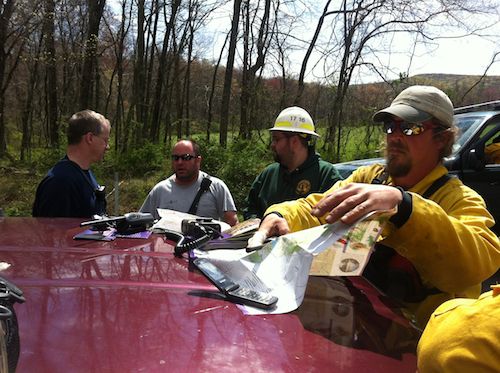
I was deployed with one of two crews led by experienced Bureau of Forestry crew bosses; these quickly-assembled crews also included local volunteer firefighters from Geigertown. Later in the day professional wildland firefighting units arrived with their pre-organized crews. In this photo fresh firefighters walk in on the Raccoon Trail between an area the main fire burned and a spot fire our crew had just isolated.
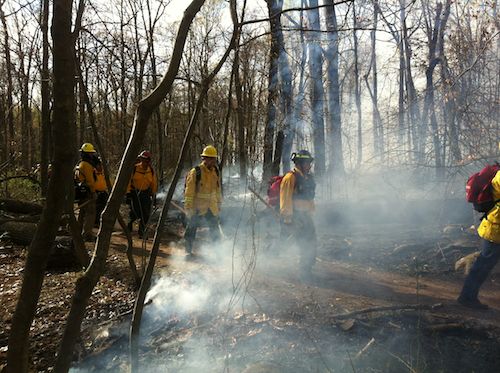
Our crew worked the southern flank along the Raccoon and Lenape Trails, so I didn’t see the head fire or the more extreme fire behavior where the wind was pushing the flames into new fuels.
We cut fireline with rakes and shovels (indirect attack) so that when the fire reached them it would go out for lack of fuel. Sometimes a wind switch blows an ember across, or even radiant heat can cause fine fuels such as leaves or grasses on the other side to ignite. If we directly attack these spots quickly we can put them out before they grow out of control.
We don’t necessarily fight this kind of wildfire with water—there’s no way to get enough of it into the backcountry. Here a fire is backing down to the Raccoon Trail which we used as a firebreak. We also tried to isolate standing dead trees near the fireline because when they ignite they spew embers into unburned fuels.
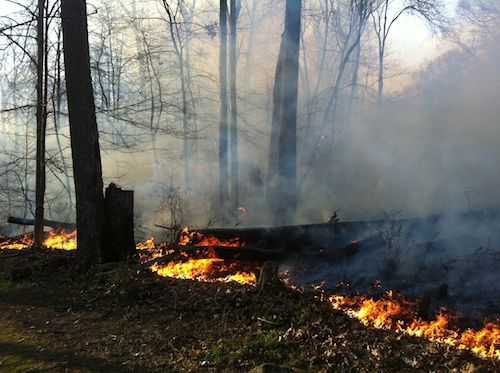
Natural Lands Trust Preserve Assistants Jarrod Shull and Sean Quinn were also on the fireline yesterday. Jarrod and I were on the first crew that went in and worked the flanks from an anchor point on Hopewell Road. Sean came by after work and went with a crew toward the front on the same flank. Here Jarrod is holding the line on the Raccoon Trail with the fire backing down to the Lenape Trail in the background.
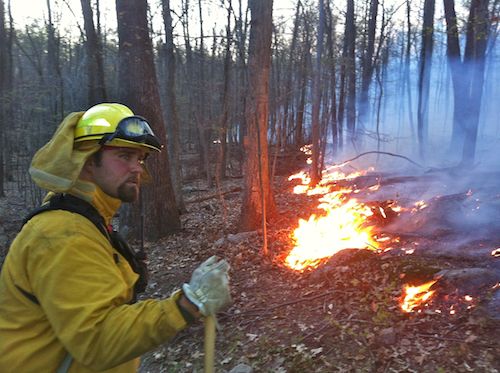
As long as the wind doesn’t switch (it didn’t here) this part is pretty quiet. But we all were looking for spots over the line that would change the picture quickly.
Fire behavior typically lessens at dusk with falling temperatures and rising relative humidity. It’s so dry now though that I was amazed to see how much still burned at night. This was only my second wildfire and it was unlike anything I had ever seen before. We had done an oak forest regeneration prescribed fire in woods at Crow’s Nest very near here in 2008 (under very different conditions) and saw much more mild fire behavior.
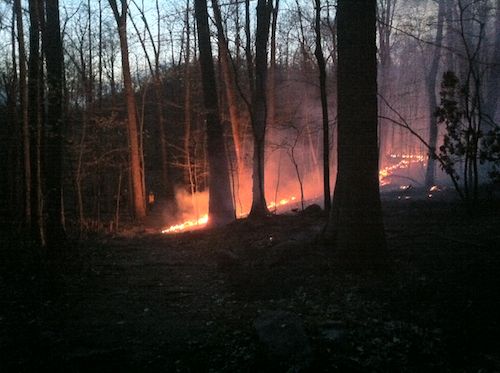
Today crews are further isolating the fire and mopping up still-burning trees. The fire danger is still great due to the weather and dry conditions so everyone must remain vigilant. The priority in fighting this fire was protecting homes in the woods at the edge of the park, and some homes were evacuated.
The park will be closed for a while yet and getting around is difficult since some local roads may be closed. Interestingly, the old French Creek fire tower has been staffed for the last few days (most fire towers have given way to satellite imagery) and that’s the place from which the smoke was first spotted. (And that’s why news reports mention Fire Tower Road as the point of origin even though it was near Route 345 and Shed Road.) The fire has burned substantial acreage on Chestnut Hill and Buzzard Hill and includes parts of Hopewell Furnace National Historic Site and French Creek State Park (it burned close to Crow’s Nest but did not enter it).
When I left the fire had burned areas around the Mill Creek Trail, reportedly out to and over Miller’s Point, over to the Buzzard Trail toward St. Peter’s Road and then down to the Raccoon Trail to the south and backing to the west toward the Lenape Trail. But the closer you get to the fire the less you see of the big picture. This blog has a picture of what the fire looked like from the top of the hill on Harmonyville Road at Crow’s Nest.
It is also important to remember that fire is a natural part of many forests. The foresters I talked to last night were very optimistic about regeneration in the park. Deer numbers are low enough that they won’t inhibit new growth of trees, and many species such as oak are dependent on wildfire to be able to outcompete more shade-tolerant but less fire-tolerant species such as beech and maple. When everything is put out and we’ve had some rain, be sure to check out the flush of growth likely to follow the fire.
Any incident like this is inevitably chaotic but I was pleased to see people from the State Parks, Bureau of Forestry, emergency responders from Berks and Chester Counties (the fire was right on the border), many local (and some not so local) fire companies, National Park Service, PA Game Commission, and all of the trained individuals who volunteered cooperating so well.
Posted by Daniel Barringer on April 10, 2012.
